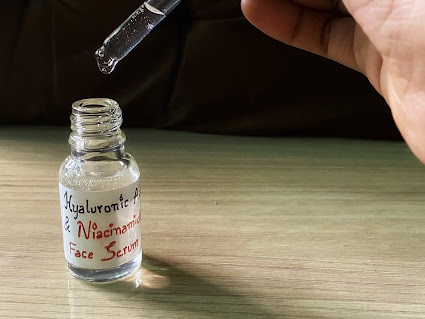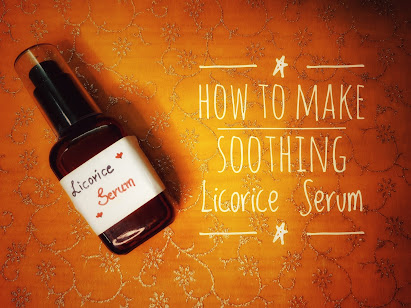DIY Moisturizing Niacinamide cream
Niacinamide (Vitamin B3) is a wonderful ingredient. It is known to improve skin texture, moisturize skin by reducing TEWL.
What is TEWL?
To explain in simple terms, water is lost from top layers of skin naturally which is called trans epidermal water loss. When excess of water is lost due to skin barrier damage caused by environmental conditions or skin problems, it results in dull skin, fine lines, etc.
Niacinamide was proven to improve skin barrier, resulting in less TEWL over period of few weeks.
Studies show that combination of Niacinamide and N-acetyl glucosamine has reduced hyper pigmentation significantly. Also, combination of Niacinamide and Retinol is known to reduce fine lines and signs of aging.
Up to 5% can be used in creams and serums. Instead of using 5% at a time, it is better to start from 2% so that you could see how skin adapts to it.
I have been using 3% Niacinamide cream for more than 2 months and I definitely see a reduction of pigmentation on my face that was caused due to acne. You will not see an immediate improvement the very next day, it takes few weeks to show the difference.
There are few things that need to be considered when formulating with Niacinamide
1) Niacinamide is found to be stable and effective at pH 6 by few studies. pH of end product can be adjusted between 5.8-6.
2) Avoid Niacinamide and Vitamin C in a product. Niacinamide when combined with Vitamin C (L-Ascorbic acid) may convert to Niacin at higher temperatures and conditions. It isn't practical but you don't want to try if you have just started formulating.
3) Niacinamide and AHA's may cause over exfoliation. So, it is better to avoid these in a single product if you have just started making skin care products.
4) Okay, then what would be a good combination with Niacinamide? Niacinamide alone is a hero ingredient. It can be combined with humectants like Glycerin, HA to improve moisturization. It can be combined with N-acetyl glucosamine or with Allantoin for sensitive skin. Niacinamide and Panthenol works great too for pigmentation and dull skin.
When to add Niacinamide?
It can be added either in water phase or mixed in the final product directly.
Let's see the ingredients required and how to make this cream.
Story behind the ingredients used:
We will now discuss on why I have used the ingredients mentioned in this product.
- Coming to Tomato seed oil and Watermelon seed oil, these are light and non-greasy carrier oils with little to no scent which add emollient properties.
- Kokum butter is non-greasy, moisturizing, compatible with many skin types and easy to work with butter. It doesn't form gritty like Shea butter.
- I wanted to use natural emulsifiers and preservatives here, that is one of the reason for using Olivem 1000. Another reason is that it forms nice and medium to thick creams.
- Olivem 1000 (Cetearyl Olivate, Sorbitan Olivate) has a soapy feel in creams, to reduce this I have added Lexfeel N. I used up to 4% before for a non-greasy and no soapy feel.
- To stabilize the emulsion, I have used Cetearyl Alcohol and Xanthan Gum.
- As you all know, allantoin is a soothing ingredient. It is my go-to ingredient in creams.
- To boost the preservative activity, I have included chelating ingredient, sodium gluconate.
- Glycerin, Ah, the effective humectant, which leaves skin moisturized and plump. Do we need a reason to add it? Definitely not :)
- Aquaxyl (Xylitylglucoside (and) Anhydroxylitol (and) Xylitol) is from Seppic. Supplier says 'Aquaxyl™ offers the 3D hydration hydraconcept for circulation of moisture throughout all skin layers and boosting of hyaluronic acid'.
- Euxyl pe 9010 is a ECOCERT approved broad spectrum preservative and works effective at pH 6 too while other natural preservatives may not be effective at that pH.
- Cucumber extract is soothing for the skin, so I have included that.
- Vitamin E Tocopherol is added to prevent oils from going rancid quickly.
- Geranium E.O and Ylang- Ylang E.O are a hit pair. Combination has such lovely and calming feel.
Ingredients required: (60g batch)
Phase A (Oil Phase):
Tomato Seed Oil 4% - (2.4g)
Water melon seed oil 3% - (1.8g)
Kokum Butter 2% - (1.2g)
Lexfeel N 2% - (1.2g)
Olivem 1000 4% - (2.4 g)
Cetearyl alcohol 2% - (1.2g)
Phase B (Water Phase):
Water 71.6% - (42.96g) + 10%(4.29g) extra to add for evaporation loss (Always distilled water)
Niacinamide 3% - (1.8g)
Allantoin 0.5% - (0.3g)
Sodium Gluconate 0.1% - (0.06g)
Xanthan Gum 0.3% - (0.18g)
Glycerine 4% - (2.4g)
Phase C (Cool down Phase):
Aquaxyl 1% - (0.6g)
Euxyl PE 9010 1% - (0.6g)
Geranium E.O 0.2% - (0.12g)
Ylang Ylang E.O 0.2% - (0.12g)
Cucumber extract 1% - (0.6g)
Vitamin E Tocopherol 0.1% - (0.06g)
Citric acid - as per the pH of end product
If you want to calculate for different batch size, I have a calculator. To check that, you can click here
Procedure:
1) Add Phase A ingredients in a beaker and melt it on a double boiler.
2) Mix Xanthan gum and glycerin to prevent any lumps, then add to Phase B ingredients. Add in another beaker and put on a double boiler until you see allantoin dissolved completely. Do not over heat.
3) Once Phase A and Phase B are melted , pour phase A to phase B (or vice versa) and blend with emulsion blender until it forms a nice cream and no more separation. You can do it in intervals(like 5 sec gap) since both the phases are hot, it will generate excess heat while blending.
4) Phase C ingredients can be added in last, once the cream comes down to room temperature.
5) Check the pH and adjust to 6. You can add citric acid if it is higher than 6 to bring it down.
6) Pour it in a cream jar or airless pump.
How to check the pH of cream?
It is better to use pH meter instead of strips to test pH .
1) Take 10% of product and 90% of water in a beaker and stir it to mix properly.
Example: 2g of product and 18g of water for 20g test sample (or) 5g of product and 45g of water for 50g test sample.
2) Dip the pH meter in distilled water and wipe with paper towel or cloth.
3) Now, put the pH meter in the test sample and stir it for few seconds and turn on the meter.
4) You will notice the pH value changing.
5) Once the pH value is constant, it can be noted as the pH of end product.
To increase pH, TEA can be added. To decrease pH, diluted citric acid or lactic acid can be added. Whenever adding pH adjusters, do remember to add only few drops at a time since it can drastically change after a point.
Substitutions:
These substitutions are mentioned so that product can be made with the ingredients that you have. Since different ingredients has different viscosity and texture, feel of finished product might be different. Key ingredients are Niacinamide, Allantoin and Aquaxyl.
1) Tomato Seed Oil and Water melon seed oil can be replaced with any light weight carrier oils that aren't heat sensitive.
2) Kokum butter can be replaced with another butter of your choice. (There will be a change in texture, when you do substitutions. So, always test a small sample to see if you like the texture)
3) Lexfeel N can be replaced with any other natural silicone replacement or dimethicone.
4) Montanov 68 or other natural emulsifier can be used in place of Olivem 1000.
5) Cetyl Alcohol would be a good swap for Cetearyl alcohol.
6) Propanediol 1,3 can be used for Glycerin.
7) Broad spectrum preservatives like Liquid Germall Plus can be used for Euxyl pe 9010. Geogard ECT may not work since it works best around pH 5 while this product's pH will be around 6.
8) Essential oils can be of your choice but note that E.O's like peppermint would tingle at this usage rate on face and essential oils like lemon, bitter orange may be photo sensitive.
9) Soothing extracts like calendula or chamomile can be added for cucumber extract.
10) Other chelating agents like Dermofeel PA 3 or EDTA can be used in place of Sodium Gluconate
11) If you don't have Aquaxyl, water can be added instead of it. It is not a replacement, just a filler.
Typical Usage Rates:
Olivem 1000 - 3 to 8%
Cetearyl alcohol - 1 to 2% as co-emulsifier
Niacinamide - 1 to 6%
Allantoin - 0.1 to 2%
Sodium Gluconate - 0.1 to 1%
Xanthan Gum - 0.1 to 2%
Aquaxyl - up to 3%
Euxyl pe 9010- 0.5 to 1%
Reference Links:
https://pubmed.ncbi.nlm.nih.gov/23220080/
https://pubmed.ncbi.nlm.nih.gov/17348991/
https://pubmed.ncbi.nlm.nih.gov/16029679/
https://www.seppic.com/en/aquaxyl
Where to Buy Ingredients - supplier links: (Click on the links to open)
You can check my page (Where to Buy Cosmetic Ingredients and Containers in India?) for local supplier details.
Do you want to watch this on Youtube? 👉 Click Here








Comments